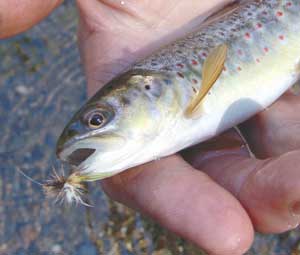
For more than 30 years, brook trout have been protected in the Great Smoky Mountains National Park. Keeping a brook trout anywhere in the park has been prohibited since 1976, and some brook trout streams were closed to fishing altogether.Now, park officials have decided brook trout are far more resilient than the experts thought. As a result, all but a few of the more than 700 miles of park streams have been opened to catch-and-keep fishing. Anglers may harvest up to five brook trout a day, seven inches or longer.
Brook trout, the only trout species native to the southern Appalachians, once inhabited nearly every watershed 2,000 feet and above. In the late 1800s and early 1900s, heavy-handed logging destroyed more than 50 percent of the brook trout’s habitat. Further adding to the brook trout’s woes was the introduction of non-native brown and rainbow trout. By the early 1970s, the brook trout’s range had shrunk another 25 percent.
Habitat loss and competition for food resources were not the only problems facing brook trout. Park biologists concluded anglers were decimating populations by catching and keeping anywhere from 50 to 100 brook trout per day.
If measures weren’t taken to protect the brook trout, biologists believed, the brook trout would be extirpated by 2000. Thus, in 1976, park officials initiated brook-trout restoration projects at selected streams and made it illegal to harvest brook trout anywhere in the park.
In 2002 park officials initiated a three-year experimental brook trout fishing project in which eight streams, four in North Carolina and four in Tennessee, would be open to catch-and-keep fishing.
“The park has two central goals in managing its fishery: to protect and restore native species and to provide an enjoyable angling experience for visitors,” said Steve Moore, chief park fisheries biologist at that time. “This … program will allow us to find out if we can do both.”
During the experiment, biologists monitored fish populations through electro-fishing. Each stream open to fishing had a nearby control stream that remained closed. Population data was analyzed on open and closed streams for three years prior to and three years after brook trout fishing was permitted.
Studies showed angling mortality was only a small part of the total annual fish mortality. In streams where harvest was permitted, biologists found numbers and length were identical in streams where harvest was permitted and streams that were closed to fishing.
Angler interviews conducted during the experiment showed 84 percent of anglers were “moderately to extremely pleased with the brook trout fishing opportunity,” park officials said.
On an average, anglers caught between five and 11 brook trout per trip. Fewer than 33 percent kept their catch. Most of the anglers were just happy to have an opportunity to catch a wild brook trout.
“Given we could find no ecological benefit to prohibiting anglers from taking brook trout, park management decided to open nearly all our streams to fishing,” Moore said.
He said a few streams still will be closed because of active brook trout restoration projects. These streams include Sams Creek, Bear Creek, and Indian Prong.
“Once these streams reach their carrying capacity, they will be opened to fishing as well,” Moore said.
Now that streams are open to catch-and-keep fishing, anglers unfamiliar with brook trout might by in for a surprise. Only a small percentage of brook trout reach the legal harvest size of 7 inches during their short life span of about three years. Most are in the 4- to 5-inch range.
Catching a native brook trout is a special thrill. Despite loss of range, harsh stream conditions, limited food resources, and competition from other species, the brook trout has endured.
Roger Lowe, fishing guide and third-generation trout fisher summed it up nicely.
“They’re a special little fish, a beautiful fish,” he said. “We’re very fortunate to have them.”




Be the first to comment